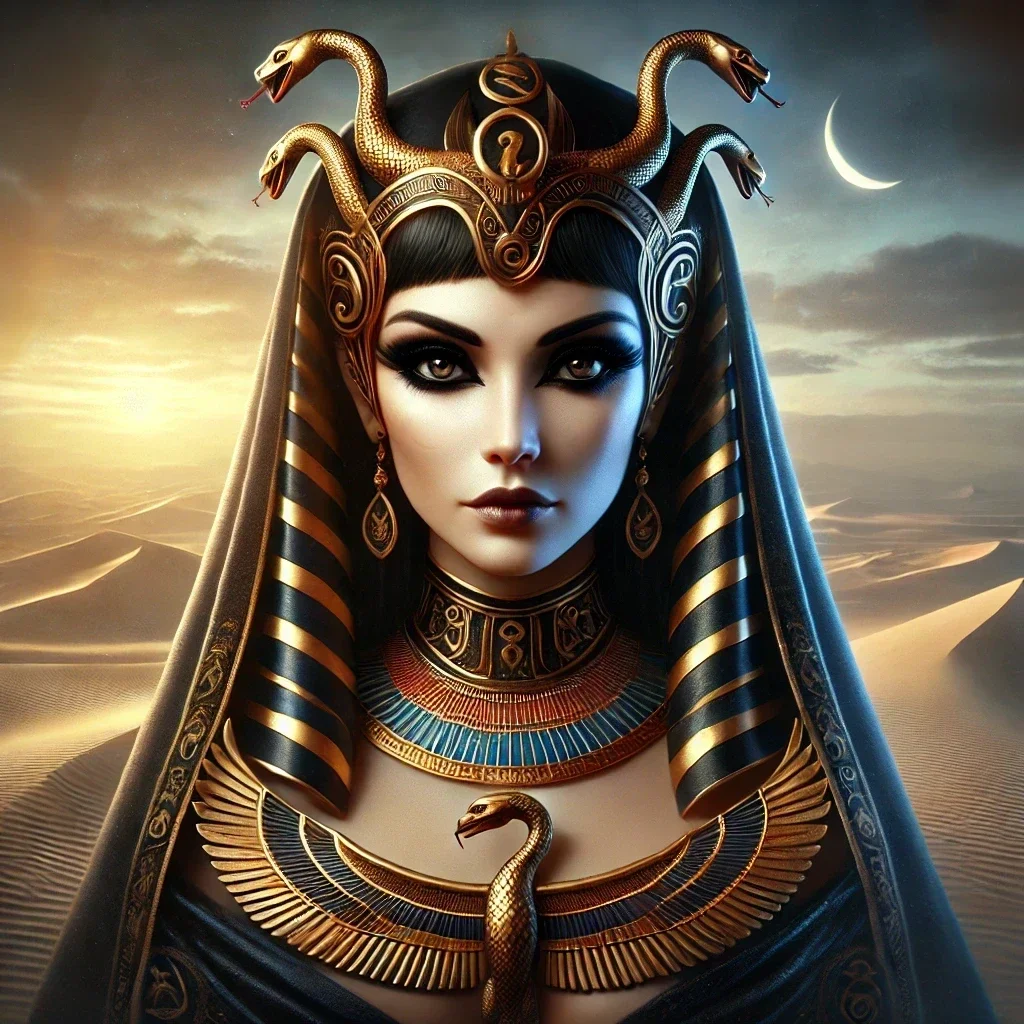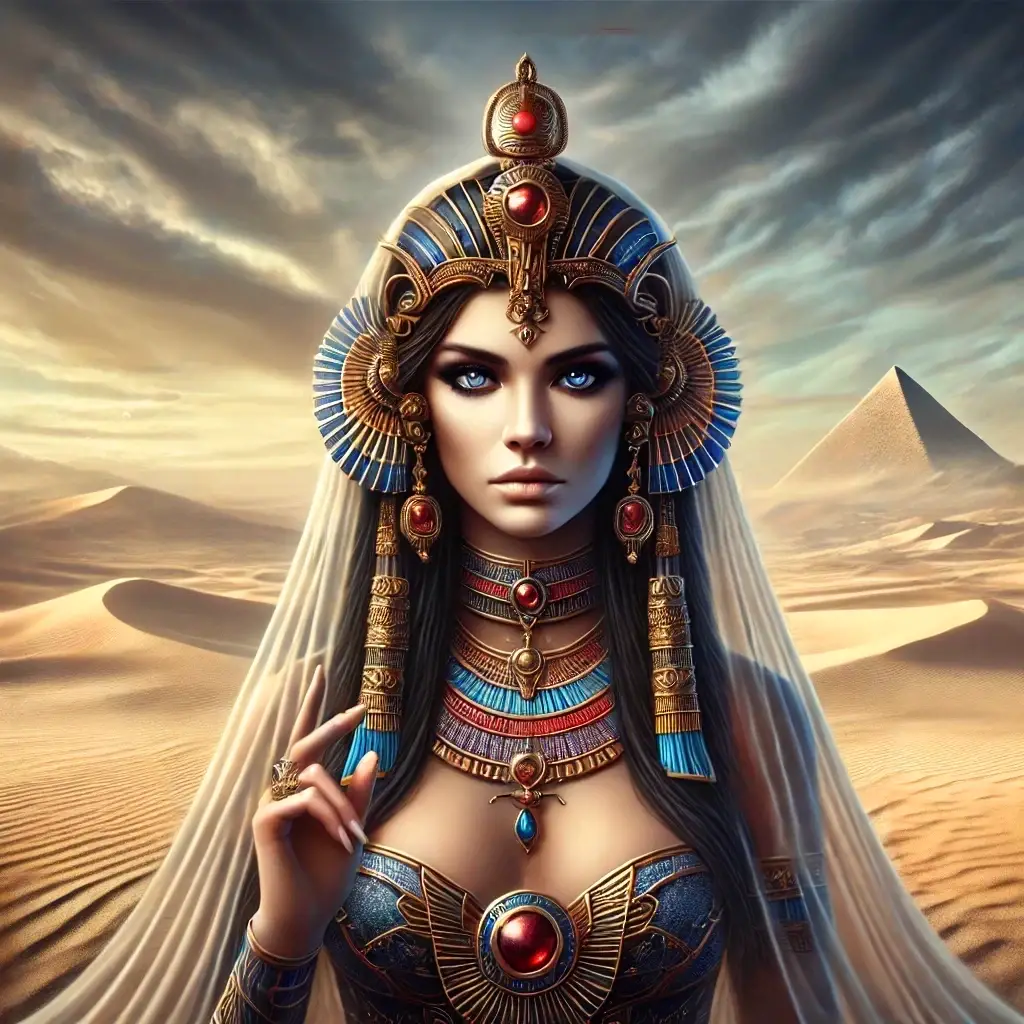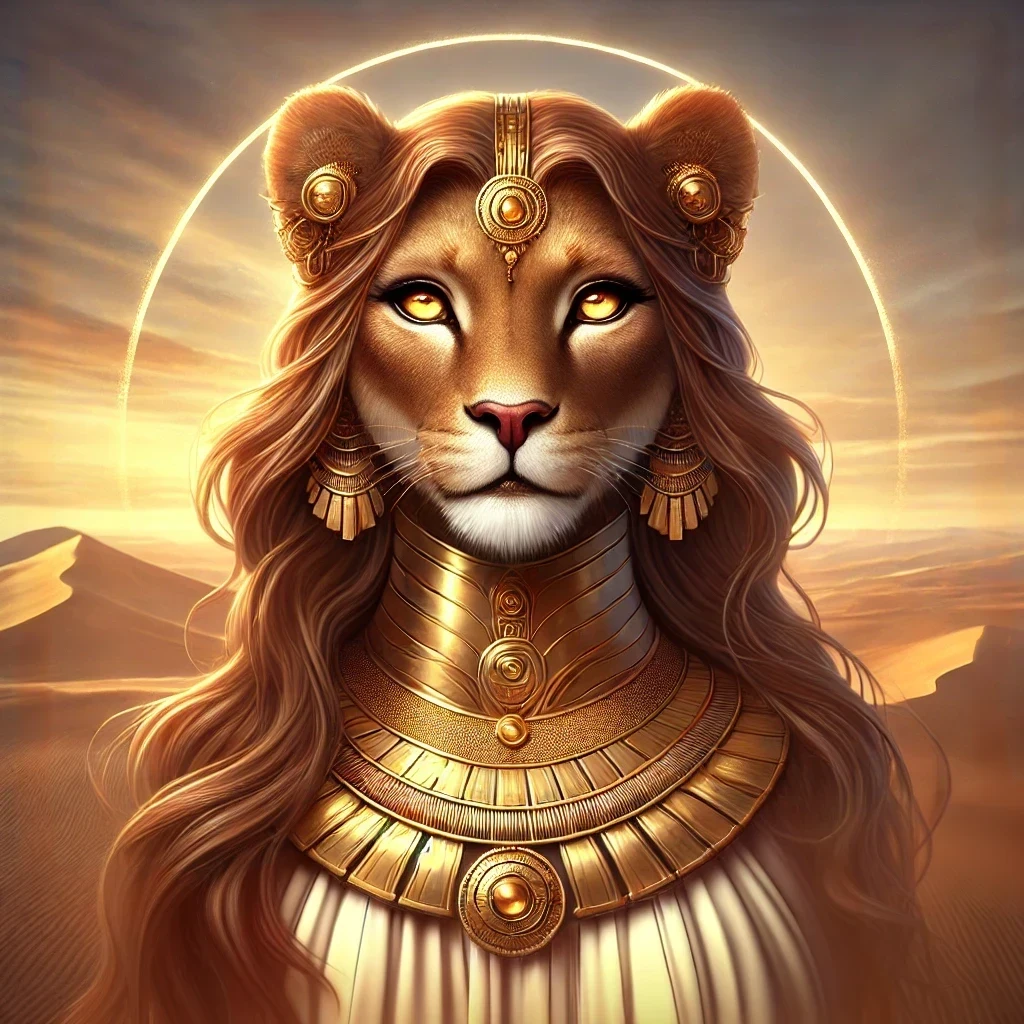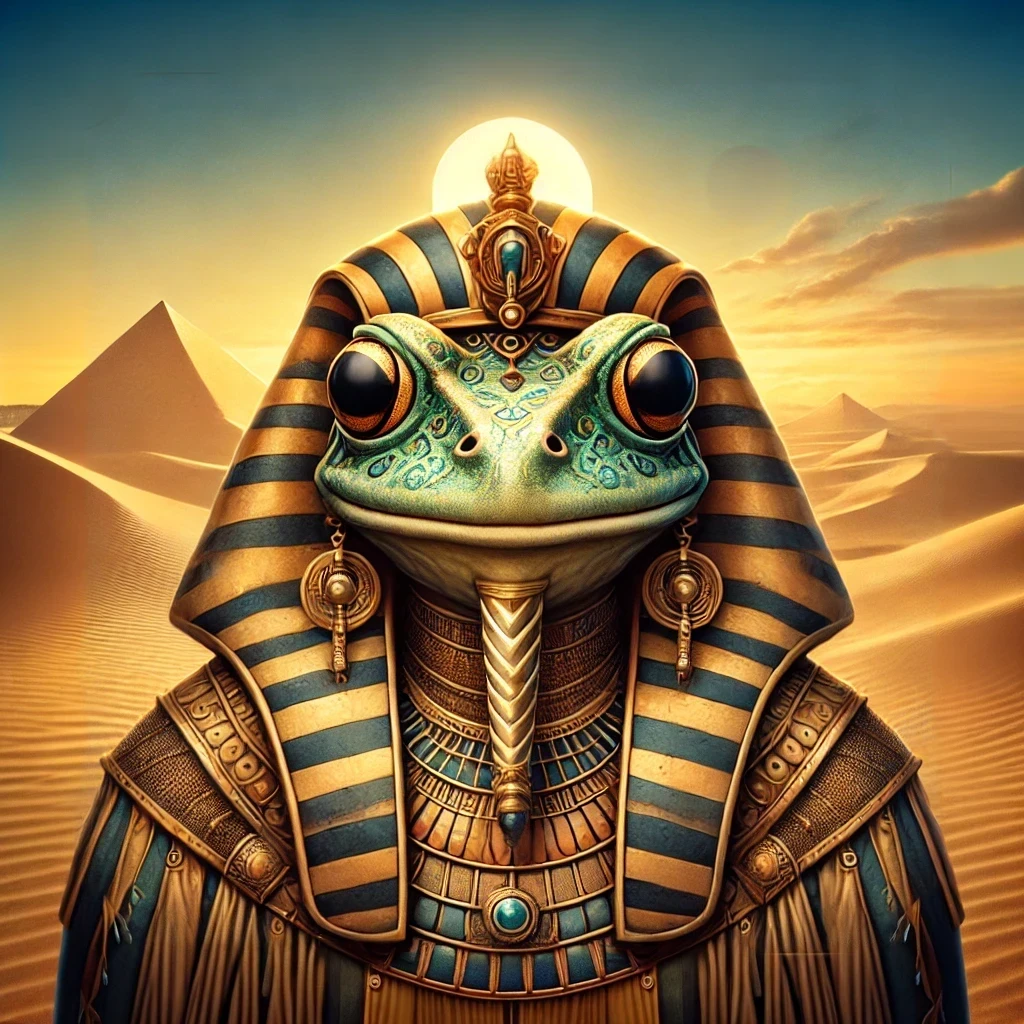Kauket represents the primordial darkness from which creation emerged. Her name, derived from the Egyptian word for darkness, is closely tied to the concept of the unknown and the infinite night before existence. Often mentioned alongside her male counterpart, Kek, she belongs to the Ogdoad, the group of eight deities worshiped in Hermopolis. As a guardian of the unseen and a force of renewal, she embodies both the abyss and the promise of rebirth. Though largely overshadowed by later solar deities, her influence remained a crucial aspect of Egyptian cosmology, symbolizing the balance between existence and nonexistence.
Origins
The Primordial Darkness
Kauket’s origins lie in the earliest layers of Egyptian thought, where creation myths framed existence as emerging from a formless, chaotic void. She, alongside Kek, personifies the deep, endless night that preceded the first act of creation. As part of the Ogdoad, her role was essential in shaping the cosmos from nonexistence. The concept of darkness was not merely an absence of light but an active, potent force that harbored the mysteries of creation.
The Hermopolitan Cosmogony
Unlike later creation myths that emphasized solar and divine birth imagery, the Hermopolitan tradition focused on abstract forces. The Ogdoad consisted of four male-female pairs, each embodying fundamental aspects of primordial chaos. Kauket and Kek governed darkness, Nu and Naunet represented the watery abyss, Amun and Amaunet symbolized hiddenness, and Heh and Hauhet embodied boundlessness. Together, they stirred the primeval waters, allowing creation to take form. The cyclical nature of this process underscored the eternal struggle between chaos and order, reinforcing her importance as an intermediary between the two.
Appearance
Depictions in Art
Visual representations of Kauket are rare, as the Ogdoad were often depicted in symbolic or conceptual forms rather than anthropomorphic figures. When portrayed, she appears as a woman with a serpent’s head, signifying transformation and the hidden knowledge of the underworld. Her depiction as a serpent also suggests a connection to renewal, wisdom, and hidden knowledge—key attributes associated with divine serpentine figures in ancient Egyptian belief.
The Serpent Connection
Serpents in Egyptian mythology were powerful symbols of both chaos and renewal. Kauket’s association with a serpent form aligns with the belief in cyclical existence, where darkness does not signify destruction but the necessary precursor to light and rebirth. The serpent’s ability to shed its skin further links her to the themes of regeneration and continuity, reinforcing her role in the perpetual cycles of existence and dissolution.
Abilities
Keeper of the Unseen
As the goddess of darkness, Kauket embodies the unseen forces that shape reality. In Egyptian thought, darkness was not simply the absence of light but a living force that held mysteries and potential. She governed the liminal spaces between visibility and obscurity, between the known and the unknown, acting as a bridge between realms.
Renewal and Cosmic Balance
Her presence ensured the continuity of cycles—day and night, life and death. She was neither purely destructive nor benign; instead, she maintained the equilibrium needed for the universe to function. The interplay between her domain and that of solar deities highlighted the Egyptian belief in cosmic duality, where opposites coexisted in a delicate balance rather than being in direct conflict.
Domain
The Night and the Void
Unlike solar deities who ruled over light and order, Kauket presided over the formless night, existing beyond the realm of the visible world. Her domain was the vast expanse before creation, a place where potential stirred before becoming manifest. The darkness she represented was not feared but revered as an essential aspect of existence.
The Underworld and Transformation
Darkness in Egyptian belief was linked to the afterlife and rebirth. The journey through the Duat (underworld) mirrored the movement of the sun, disappearing each evening into the abyss before rising anew. Kauket’s presence in these beliefs underscores her role as a guardian of passage and transformation. Her domain extended beyond the physical world into the metaphysical, where the unseen dictated the fate of souls and the continuation of cosmic order.
Myths
The Birth of Light
One of the most fundamental stories tied to Kauket and Kek describes how they, along with the other Ogdoad deities, churned the primordial waters to initiate creation. Their efforts gave rise to the first landmass and the divine sun, which emerged from the chaos they once ruled. This act established the fundamental belief in the cyclical interplay of darkness and light, where the night served as the birthplace of illumination.
The Eternal Cycle
Though not featured prominently in individual myths, her role in the cosmological cycle remained ever-present. She existed at the threshold between oblivion and creation, ensuring that the world did not lapse back into nonexistence. This continuous cycle reinforced her significance as a sustaining force rather than an antagonist to creation.
Symbolism
Darkness as Potential
Rather than a malevolent force, darkness was seen as a necessary counterbalance to light. Kauket symbolized the hidden forces that make growth and renewal possible, much like a seed buried in the soil before it sprouts. This representation of darkness as an active state of gestation rather than destruction made her an essential part of Egyptian cosmology.
Animals and Objects
Serpents, as creatures that shed their skin, were her most common association, representing transformation and renewal. Other symbols linked to her include the deep waters of Nun, the formless void that held the ingredients of creation. The nocturnal creatures that thrived in darkness, such as owls, may have also been linked to Kauket, serving as intermediaries between the visible and the hidden worlds.
Worship
Temples and Centers of Worship
While not widely venerated with dedicated temples, she was recognized in Hermopolis, where the Ogdoad were honored. This site was a major religious center for understanding creation and the forces that predated the gods of popular Egyptian worship. Her presence in these theological discussions suggests that she was regarded as a fundamental, if not directly worshiped, force in the structure of the cosmos.
Rituals and Devotion
Kauket’s veneration likely involved nocturnal rituals, emphasizing the mysteries of the unseen world. Priests and initiates who sought knowledge of the hidden aspects of existence may have invoked her through secret rites. The association of darkness with divine revelation suggests that her followers may have engaged in meditative or vision-inducing practices to connect with her essence.
Evolution Over Time
With the rise of more prominent solar deities like Ra and Amun-Ra, the influence of the Ogdoad diminished. However, the concepts they embodied—such as darkness, infinity, and transformation—remained integral to Egyptian religious thought. Her attributes were often absorbed into other deities who maintained aspects of her domain.
Associations
Kek, the Male Counterpart
As part of a divine pair, Kauket was eternally linked to Kek, the male aspect of darkness. Together, they formed a duality that underscored Egyptian beliefs in balance and symmetry.
The Ogdoad’s Role in Egyptian Theology
The broader group of the Ogdoad served as a foundation for later religious developments. While more anthropomorphic deities gained prominence, the abstract forces they represented never lost their significance.
Legacy
Decline and Absorption
With the shifting religious landscape of Egypt, her role gradually faded. However, echoes of her symbolism persisted, especially in esoteric traditions that valued the concept of darkness as a source of hidden knowledge. The transition from polytheistic to monotheistic religious practices further contributed to the loss of her distinct identity.
Influence on Later Thought
Even after Kauket’s cult diminished, the philosophical idea of darkness as a necessary counterpart to creation influenced later religious and mystical traditions. The balance between light and dark, order and chaos, continued to be a central theme in Egyptian cosmology. Her essence can be seen in later mythologies and religious ideologies that embrace duality as a fundamental principle.
Rediscovery and Modern Interest
Today, scholars and enthusiasts of ancient mythology explore her role as a crucial yet enigmatic figure in Egyptian thought. She stands as a testament to the depth and complexity of the civilization’s religious traditions, reminding us that even in the deepest darkness, creation stirs.
Trivia
- Etymology Mystery: The exact pronunciation of her name is uncertain, as vowels were rarely recorded in Egyptian hieroglyphs.
- Dual Nature: Unlike many gods, Kauket was neither wholly benevolent nor malevolent—darkness was seen as a necessary balance.
- Symbolism in Duality: She was always paired with Kek, mirroring the Egyptian belief in harmony through opposites.
- Rare Depictions: While other deities had temples and statues, she was mostly represented through hieroglyphic inscriptions.
- Underworld Connection: Some later myths suggest she played a role in guiding souls through the Duat.
- Influence on Later Thought: Elements of Kauket’s symbolism influenced Greco-Roman and later esoteric traditions.
- Nocturnal Rituals: Ancient priests may have performed nighttime rites to honor her unseen power.
- Unwritten Myths: Due to the secretive nature of her worship, much of her lore remains unknown.
- Philosophical Influence: Egyptian concepts of darkness influenced later religious mysticism.
- Enduring Mystery: She remains one of the least understood yet most intriguing deities in Egyptian mythology.



